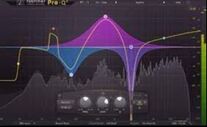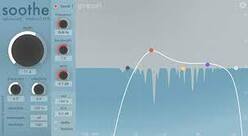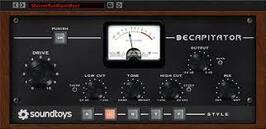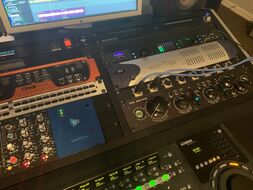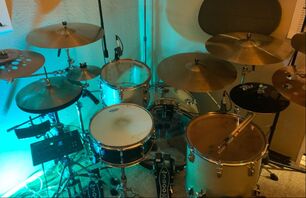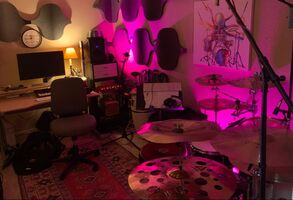The Audio Nerd Log
When I was a kid, the record jacket was like a crackerjack box where the surprise prize might be a treasure trove of inside info on how the record was made. I always wanted to know what they used and how they did it. I got pretty good at identifying any gear visible from candid studio photos. Yet now in the internet age it puzzles me why so few people share any usable info.
So on our last project (Turf Fire Liars) I did a page like this for the followers of Warren Huart on YouTube and I don't know that anyone looked at it. But in the off chances we do draw in an audio nerd or two I thought we'd do another version of it. The truth is I'm an audio nerd so be careful, don't fane some half hearted question about recording geekdom unless you have a few hours to burn. So let's get our audio nerd on.
So on our last project (Turf Fire Liars) I did a page like this for the followers of Warren Huart on YouTube and I don't know that anyone looked at it. But in the off chances we do draw in an audio nerd or two I thought we'd do another version of it. The truth is I'm an audio nerd so be careful, don't fane some half hearted question about recording geekdom unless you have a few hours to burn. So let's get our audio nerd on.
Top 5 mixing takeaways from this project
|
IT IS NOT ABOUT THE GEAR!
On this topic we are all hypocrites. Respecting all the amazing records from not only back in the day but right now, made with scornful equipment, at face value we all fully accept that it is not about the gear. It is about the tone in your hands, how you listen and your skill with whatever you have. Yeah all that is true, to a point and yet we all lust for more and better gear, snob out if someone chooses something other than what we would have done or cut a cost somewhere we wouldn't have. Guilty! But this list below will also show a pretty wide range of gear and affordability all quite useful in this production.
Software & Plugins
I'm still a Pro Tools guy though the cost has me starting to check out other options. This project was also pretty straight forward in terms of effects and such. A quick word on plug-ins. I have too many. Don't fall into that trap. Just like hardware, get only what you know you will use. Unlike hardware there really isn't used market. Here are some of my main go-tos.
- EQs: Fabfilter EQ-3,
- Dynamics: Fabfilter Pro-C, Stock Pro Tools dynamics/gate/de-s, Soothe, McDSP ML-1
- Reverbs: Revolver, D-Verb, ReVibe,
- Delays and Modulations: EchoBoy, EC-3000, Waves j37
- Harmonics and Saturation: Decapitator, SansAmp,
- Tools; Izotope de-noise and de-click, Vocalign Project, AutoTune.
Hardware & outboard gear
I have traditionally been an all in the box dude, never buying into the hype of the hybrid mixing model. Convenient for me, because I couldn't afford it anyway. But now I'm starting to think there may be something to it. On this project I experimented with my limited outboard gear as mixing tools, not just for tracking. While comparatively cumbersome, I believe for some elements like lead vocals they can make a difference. I know we are getting into the realm of religion here, but hear me out. I'm inclined to believe (without proof) that some analog equipment can add some harmonics and tonal characteristics by the nature of their components. The hardware introduces a nuance that is nearly impossible to reproduce with software (even using IRs). One could speculate about the nonlinear aspects of analog op-amps and other components or the perceptual differences between tactile and visual cues, or maybe the limitations of my skills, I can't say but I "think" I hear a difference on some elements.
- EQs: 500 series API 550B, JDK V14
- Dynamics: Manley El-Op, DBX 560A
Jake Thorne's Signal Chain
|
- Saxophones: Yamaha 61 Tenor with a Brilhart #7 mouthpiece and some off brand Czech built recycled soviet personnel carrier for a Bari sax with a basic Yamaha #5 mouthpiece, EV RE20, 500 Series BAE 1073 MLP, Manley El-Op, UA Apollo 8, Pro Tools.
- Keyboards: All virtual, hey I see you turning your nose up but you probably didn't give it a thought before I told you. MTron virtual mellotron, AIR instruments Velvet Electric Piano, DB-33 and Xpand, Organs, The Rizer and Vacuum soft synths as well as East West Silver Strings and brass.
Will Thorne' recording details
Under normal circumstances we would record Will at my place or at j-32 in San Jose. But as COVID dragged on we needed a basic set up for Will at his home as well. Most of Will's backing vocals and even a few of his leads he recorded with the following home setup.
- Shure SM-7B, with a Cloudlifter into an Audient iD14. in to Pro Tools.
- While at J-32, a Sennheiser 441 and a Soundelux U99 into an API 512C, a UA Apollo interface into Pro Tools.
Jake Schaefer's Signal Chain
- Electric Guitars: Guitars: 1968 Fender Telecaster, Fender CS '61 Stratocaster. Amps: 1978 Fender Vibro Champ, Fender Pro Jr, Matchless C30. Effects: Fender ’63 spring reverb.
- Recording chain: Royer 121 and Shure SM57 mics, Shadow Hills GAMA mic pres, API 527 comps, API 550b EQs, Pro Tools Carbon 32bit audio interface running Pro Tools Ultimate software.
Trey Sabatelli's set up
- Drums: 3 piece 1969 Silver Sparkle Ludwig set (8x12, 16x16, 14x22), Joe Montineri custom black iron snare drum (6x14) very heavy! Hardware/pedals: DW 5000
- Cymbals: Paiste cymbals: 17” & 19” Signature Full Crash, 21” Signature Full Ride, 13” Signature Hi Hat medium bottom (on top), 13” Sound Formula Reflector medium bottom (on bottom), 18” Alpha Reflector Swiss Crash , 12” PST X Swiss Flanger crash
- Mics: SM57 (snare), Audio Technica ATM25 (kick), Sennheiser e604 (toms), modified Oktava MK-012 (over heads)
- Pre Amp/Interface: Focusrite Red 1 mic pre, Focusrite Scarlett 18i8
- DAW: Pro Tools
Ken Hughes' Set up
- Vocal chain: sE Electronics Z3300 FET mic ART Pro-Tube II with upgraded 12AX7, “warm vocal” or “neutral” preset Focusrite Scarlett 18i20 interface
- Organs: Hammond M-3 into Motion Sound Pro-3T (w/upgraded tube) and Low Pro. Mics: Blue 8-Ball on low, SM57s left and right on top Transistor organs from E-Mu Vintage Pro and Jiggery Pokery Combo X-705 plug-in.
- Electric pianos: Crumar Seven
Our Writing Process
I typically write a framework for the music of a verse and chorus, of chords and melody and I try to write twice as many as we think we'll use. I send those off to Will with some theme ideas which he may or may not use. Then he comes up with a story for the feel of the song and we start the process of fitting his words to the melody. Depending on the note or the word choice we may bend one to fit the other. On this project the notable exceptions were Father time and and Steamer Lane where Will had the lyrics first and I wrote the music to them.
For the longest time I couldn't write a bridge and now I feel like it is the part of the song that reveals the the skill level of the songwriter more than anything. We do it differently every time and it tends to have the most iterations. We are not the kind of writers who bust out something in 10 minutes and think it is a finished product. Maybe it is because we can't or maybe because we over think it but that hasn't ever happened to us. Then there is the question of who is going to sing it, which typically isn't much of a question.
For writing the music I might start with just a few chords voiced rather open so that a melody has more room to sprout. If nothing comes right away I begin to change up major and minor or add a 7th to push my ear in one direction or another. If the melody wants to leave the chords, I go with it. The melody has right of way. After the melody feels solid I might go back and try chord substitutions. If the melody requires simple chords I might move the bass notes around to destabilize sections of the verse to make the chorus feel more like a home base. These are just some suggestions that seem to be working for me at the moment.
I typically write a framework for the music of a verse and chorus, of chords and melody and I try to write twice as many as we think we'll use. I send those off to Will with some theme ideas which he may or may not use. Then he comes up with a story for the feel of the song and we start the process of fitting his words to the melody. Depending on the note or the word choice we may bend one to fit the other. On this project the notable exceptions were Father time and and Steamer Lane where Will had the lyrics first and I wrote the music to them.
For the longest time I couldn't write a bridge and now I feel like it is the part of the song that reveals the the skill level of the songwriter more than anything. We do it differently every time and it tends to have the most iterations. We are not the kind of writers who bust out something in 10 minutes and think it is a finished product. Maybe it is because we can't or maybe because we over think it but that hasn't ever happened to us. Then there is the question of who is going to sing it, which typically isn't much of a question.
For writing the music I might start with just a few chords voiced rather open so that a melody has more room to sprout. If nothing comes right away I begin to change up major and minor or add a 7th to push my ear in one direction or another. If the melody wants to leave the chords, I go with it. The melody has right of way. After the melody feels solid I might go back and try chord substitutions. If the melody requires simple chords I might move the bass notes around to destabilize sections of the verse to make the chorus feel more like a home base. These are just some suggestions that seem to be working for me at the moment.
Green Room Janitors
Copyright © 2021





